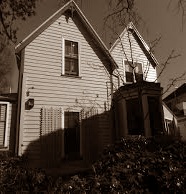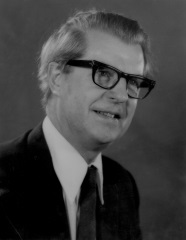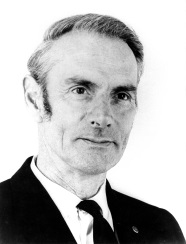The early years
Seventy years ago, with the Second World War ending and the country at last facing good economic prospects, the University of Otago agreed to establish a geography programme and appointed Mr Benjamin Garnier as lecturer-in-charge. Ten years earlier the Association of Heads of Registered Secondary Schools had asked the University to offer a full degree course in geography, but it took the influx of returned services personnel and recognition of the national need for teachers with social studies training to spur action.
As a high school teaching subject, geography was as popular in the 1940s as it is today, but even though Auckland and Canterbury university colleges hosted undergraduate and postgraduate geography programmes they were unable to satisfy the national demand for geography graduates prepared to train as high school teachers, so it was inevitable that other colleges of the University of New Zealand would follow suit. Initially appointed to satisfy the growing need for high school geography teachers, staff quickly perceived further prospects for the discipline and more diverse employment opportunities for its graduates in New Zealand and abroad.
While a member of the academic staff of Canterbury University College in Christchurch, the British-trained geographer, Kenneth Cumberland, had documented the direct and indirect effects of people on the country's soils in an important and influential book (Soil Erosion in New Zealand: a geographic reconnaissance, Wellington, 1944) but it was Ron Lister who recognised the need for environmental and resource planning and set about training young people to occupy those niches.
For the first 36 years of its existence, first Benjamin Garnier then Ronald Lister headed what was to become the Department of Geography at the University of Otago. Before they were appointed, the eminent anthropologist, Curator of the Otago Museum and Hocken Librarian, BF Skinner, had offered lectures to undergraduate students on geographical topics, as had academic staff of the Department of Geology, but it was only after Ben was appointed in 1946 that a full degree programme in geography could be offered to undergraduate students.
 The first lecture in the Otago geography programme was scheduled for a March afternoon in 1946 and Mellor House was the venue. It had been a family home, and was used by the University as a residence for male students. Accommodation was found for the fledgling department by combining two ground floor rooms into a lecture room, next to which was a staff office in what had been the pantry off the kitchen. In February 1946, those rooms lacked furniture although the 'office' had a built-in sink. Right from the start it was a simple matter to establish what was to become the Departmental tradition of tea and coffee breaks!
The first lecture in the Otago geography programme was scheduled for a March afternoon in 1946 and Mellor House was the venue. It had been a family home, and was used by the University as a residence for male students. Accommodation was found for the fledgling department by combining two ground floor rooms into a lecture room, next to which was a staff office in what had been the pantry off the kitchen. In February 1946, those rooms lacked furniture although the 'office' had a built-in sink. Right from the start it was a simple matter to establish what was to become the Departmental tradition of tea and coffee breaks!
With just four weeks before the beginning of term, the prime need was to order the minimum of furniture necessary to make the lecture room functional. On the morning of the first day of classes, with the students scheduled to assemble at 4pm, only a blackboard and a low platform for the lecturer were in place. Soon after lunch, to Ben's relief, a van arrived with tables and chairs, and all was made ready for the first lecture in the University's new geography programme. From Mellor to Hocken, published in 1995 by the Department of Geography, contains 43 personal accounts by present and former staff and students over the half century since its foundation.
 Benjamin Garnier: 1946 - 1951
Benjamin Garnier: 1946 - 1951
Benjamin Garnier was born of missionary parents in Tsinan, northern China, and graduated MA in geography from St Catherine's College, Cambridge. After a short period as lecturer-in-charge of geography at Wellington Technical College he was appointed lecturer-in-charge of geography at Otago, where he remained for seven years before taking up appointments first at the University of Ibadan in Nigeria and then at Indiana University in the United States of America. In 1965 he moved to McGill University in Montreal, where he was Professor of Climatology until his retirement in 1982. Ben and his wife Vanna shifted to northern Italy the following decade, where he died in 2010 at the age of 93 years. Throughout his career, he published widely but is perhaps best known in New Zealand for two books, The Face of Otago (Christchurch, 1948) and The Climate of New Zealand (London. 1959).
When Ben entered the lecture room on the first day of classes in 1946 he could hardly believe his eyes. Every seat was taken! Some students were seated at the tables, others were leaning against the walls, and a substantial number had to stand on the verandah outside the lecture room. Rather than the 20 to 25 students whom he had been advised to expect, between 70 and 80 undergraduates had decided to study geography at Otago. Ben's planned lecture had to be rescheduled -- but he took the opportunity to speak about the course, welcome the students, and express pleasure at seeing so many people -- until he could find a larger room for the class.
In retrospect, it is not surprising that enrolment for the inaugural class was so large. For many years before 1946, geography had been fairly well established in New Zealand high schools. The introduction of degree programmes in geography, along with strong support for and interest in the New Zealand Geographical Society, showed that public interest in geography extended well beyond the pedagogic and academic spheres, and the New Zealand Geographer, which was first published in 1945, was soon seen as a quality outlet for geographical research.
 Ronald Lister: 1951 - 1982
Ronald Lister: 1951 - 1982
Ronald Lister was also a British-trained geographer. After war service in south Asia, he was appointed to a staff position in the recently-established Department of Geography at Auckland University College. In 1951, after Ben had left for Ibadan, Ron was appointed lecturer-in- charge of geography at Otago, and remained on the academic staff of the University until he retired as Professor of Geography early in 1982. The early history of geography at Otago is best seen against the background of changes taking place in academic geography across the world, particularly in Great Britain, Western Europe and North America, and Ron strove to move the geography from a largely descriptive to an analytical discipline. At Otago, as elsewhere in New Zealand, geography grew in popularity and status. Ron also understood the importance of resource management and planning, and succeeded in his bid to base instruction for a new, interdisciplinary planning qualification in the Department of Geography. To that end, he was instrumental in hiring the Canadian-trained, Kenyan planner, Dr Pyar Ali Memon, to serve as Director of the fledgling planning programme.
In Ron's years as head of department, the Otago geography programme grew vigorously, and students were able to follow undergraduate and postgraduate programmes in geography, undertake study for professionally recognised postgraduate qualifications in planning, and enrol for the PhD. The University made Ron an Emeritus Professor in 1982, and he remained a valued and productive member of local, regional and national committees and organisations until his premature death in 1985.
